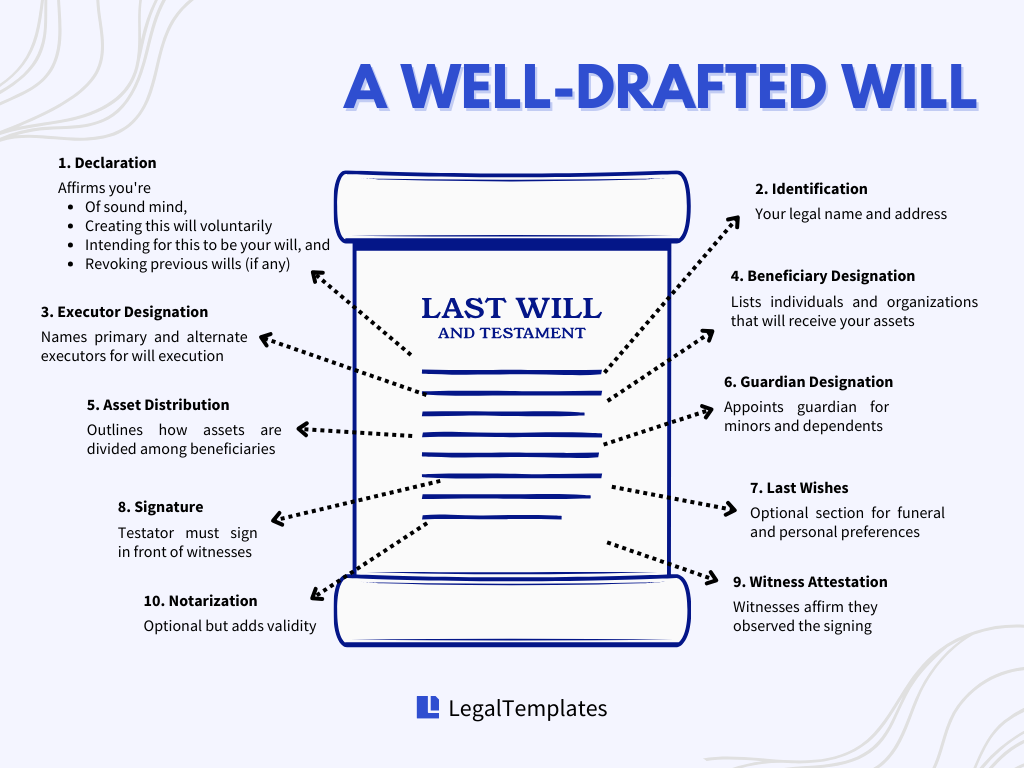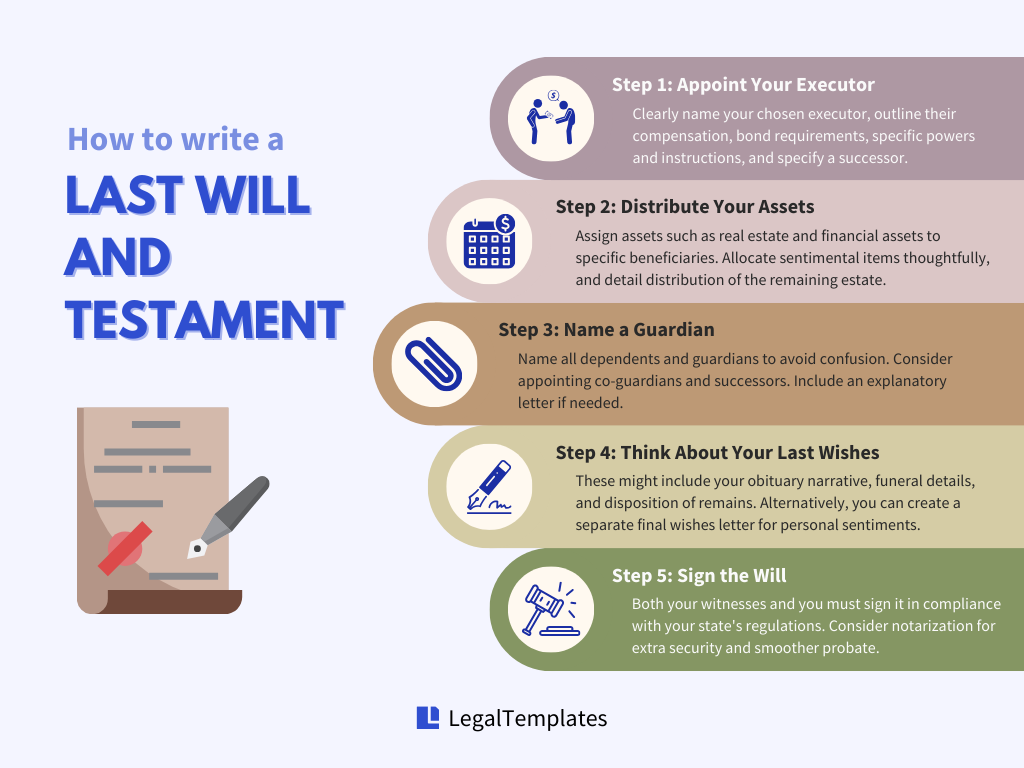
Understanding how to write a will, also known as a last will and testament, is essential to creating your estate plan. Having a will in place ensures your assets and possessions are distributed according to your wishes, reducing the risk of family quarrels and legal hassles.
Traditionally, most people relied on lawyers for drafting wills and other estate planning documents. Today, with online resources, writing a valid will on your own is feasible. If you’re wondering, “Can I write my essay or draft a will without professional help?” the answer lies in leveraging these resources. Follow estate planning attorney Susan Chai‘s complete walkthrough from below.
Note
Make sure you have prepared for your will before you start writing.
How to Write a Will Yourself: 5 Steps

Typically, a well-drafted will contains the following elements:
- Declaration: Affirms you’re of sound mind, creating this will voluntarily, intending for this to be your will and revoking previous wills.
- Identification Details: Your full legal name and address to avoid ambiguities.
- Executor Designation: Names the person overseeing the will’s execution and potentially a successor or alternate executor.
- Beneficiary Designation: Lists who will receive your assets, be it individuals or organizations.
- Asset Distribution: Details how assets are distributed among beneficiaries.
- Guardianship Designation: Names the guardian for minor children or dependents.
- Last Wishes: Non-mandatory section for funeral preferences.
- Signatures: Your signature, made in the presence of witnesses.
- Witness Attestation: Witnesses’ signatures, confirming they saw you sign.
- Notarization (optional): An extra step for validity, although not always required.
Let’s take a closer look at what to consider when addressing these elements in your will.

Step 1: Name Your Executor
After you’ve decided whom to appoint as your executor, you should specify who they are and what they are authorized to do, including:
- Executor’s Name: Clearly state the full name of the person you’ve chosen to be your executor.
- Compensation: State if the executor will be compensated for their efforts. If so, specify how—whether it’s a reasonable amount based on the work involved, a fixed sum, a percentage of the estate, or any other payment structure you prefer.
- Executor’s Bond: Indicate if the executor needs to post an executor’s bond. This is a type of insurance that protects the estate from any losses caused by the executor’s mistakes or misconduct. It acts as a safeguard for the beneficiaries.
- Specific Powers: Specify the specific powers you’re granting to the executor. For instance, the authority to sell real estate, manage investments, distribute assets, pay off debts, or any other responsibilities that go beyond the standard powers of an executor.
- Payment of Debts & Expenses: Define how the executor should handle the settlement of your debts and other expenses. You may instruct the executor to address them from the total remaining after the estate has been distributed or in any other way you prefer.
- Successor Executor: There may come a time when your initial executor becomes unable or unwilling to serve as executor. If you did not name a successor executor, the court will name someone you may not want as executor.
Step 2: Distribute Your Assets
If you want to ensure your assets go to the right people after you die, be extremely specific about what assets to include, who will receive what assets, and how you’d like to distribute your assets in your will. Here’s a breakdown of what to consider when distributing different types of assets:
Real Estate
This includes any land or houses you may own. It’s easier to give a specific property to just one beneficiary whenever possible to avoid potential disagreements. If you do decide to leave a property to multiple beneficiaries, provide the ownership breakdown and consider specifying how they may manage or distribute it together (i.e., allowing one beneficiary to buy out the other at a predetermined market value).
Financial Accounts and Personal Property
This includes cash and any personal property from motor vehicles to furniture. Provide detailed instructions on who gets what, as this will make the distribution process smoother. Similar to real estate, consider giving valuable assets to an individual beneficiary rather than giving to multiple beneficiaries to be divided equally.
In addition, regularly review the beneficiaries you’ve listed for assets that pass directly to those named beneficiaries such as for retirement accounts or insurance policies. Such designations can sometimes take precedence over what’s stated in your will. For easier transfers, especially for assets like bank accounts, you might want to consider adding a beneficiary as a joint account holder or a TOD beneficiary.
If you are leaving money to a minor child, it is a good idea to create a trust and appoint a trustee to manage the assets for the minor beneficiary until the child reaches an adult age.
Sentimental Items
Begin by considering the emotional ties your loved ones might have to specific items. Whenever you can, try to allocate such special items to those who cherish their memories the most. If you ever feel that some decisions might raise eyebrows or questions, you can always write a separate note explaining your choices.
Remaining Estate
Once your property has been distributed according to your will, and all debts and expenses have been paid and settled, there might still be a part of your estate that remains. You should clarify your preferred priority in distributing your remaining estate; this can be to one or multiple recipients.
In addition to specific instructions regarding how your assets should be distributed, you should also consider adding specific instructions on how to announce the distribution, i.e., if you want a formal reading of the will or a private meeting with each beneficiary.
If you have significant or complex assets, such as businesses, consider consulting an estate planning attorney. Their expertise can guide you in navigating estate taxes, ensuring that your wealth is efficiently and properly transferred to beneficiaries.
Step 3: Specify Your Guardian
After providing clear instructions on how to distribute your assets, the next step is determining guardianship for any dependents you have.
Begin by clearly stating the full legal names of your dependents (whether they’re your minor children or others you care for) and your chosen guardian(s). This step ensures there’s no ambiguity about whom the guardianship concerns.
In addition, consider appointing co-guardians, such as a grandmother and grandfather, and successor guardians if the initial guardian(s) are unable to accept. If you do, be sure to include all guardians’ full legal names.
Sometimes, the chosen guardian might raise eyebrows or questions, especially if your family dynamics are complex. If you anticipate this, consider including a letter of explanation to elaborate on your choice. This can provide clarity about why you believe this individual is best suited to care for your child, focusing on financial stability, shared values, the child’s needs, their relationship with the guardian, and even the child’s preferences.
If you foresee a contentious situation arising from your guardianship decision, or if there’s an ongoing child custody issue, seeking advice from a qualified attorney is always a good idea. After all, the essence of appointing a guardian is to ensure your dependents’ well-being, and your will should reflect that primary concern.
Step 4: Think About Your Last Wishes
After outlining crucial guardianship decisions, you can start considering if you’d like to include your last or final wishes in your will.
While not legally required and not necessarily legally related, your last wishes allow you to express your final thoughts and sentiments, providing comfort and clarity to those you leave behind. Some aspects you might consider include:
- Obituary Information: Share your preferred narrative, highlighting notable events, accomplishments, or fond memories that you’d want to be remembered by.
- Funeral or Memorial Service Details: Specify your wishes about the service’s location, rituals, readings, or music. This ensures your memorial feels uniquely ‘you’.
- Disposition of Remains: Clarify whether you favor burial, cremation, or another method. Mention any special locations or instructions concerning where you’d like to rest.
Alternatively, you can create a separate last or final wishes letter as a part of your estate plan.
Step 5: Sign the Will
Once you have completed your will with unambiguous, specific language, it’s time to seal your decisions with your signature.
Before signing, make sure to check your state’s regulations. Different states have varying requirements about the number of witnesses, qualifications to be witnesses, and the necessity of notarization.
After you sign, the witnesses must then sign the will, affirming they witnessed your signature and you were competent and of sound mind when signing. Remember, incorrectly executing a will might render it invalid, so utmost care is required during this process.
While not always necessary, notarization can be an added layer of security. Only some states mandate notarization, but many others accept a notarized self-proving affidavit, which can expedite the probate process later on. Even if not mandatory in your state, considering notarization can offer added peace of mind.
What is a self-proving affidavit?
A self-proving affidavit is a sworn statement attached to a will, confirming its authenticity without the need for witnesses to testify in court. Witnesses sign this affidavit before a notary public, verifying that they saw the will’s creator sign the will voluntarily and that it represents their true intentions for asset distribution. Note that in a handful of states, wills are automatically self-proving so self-proving affidavits are unnecessary.
After You Completed Your Will
Keep It Safe
Your loved ones should have immediate access to your last will and testament after your death.
Although states do not require you to officially record your completed will, some states and counties allow you to log information about your will or file it with a probate court.
If you use an estate attorney to write your will, they will likely offer to store it at their office for safekeeping. However, if you’ve decided to draft your own will, somebody reliable should know where you’ve stored it and any associated documents. You can store the will in a safety deposit box in a bank, a drawer or safe in your home office, or with a trusted friend or family member. Regardless, you should notify your family that you have a will in place so your final wishes can be carried out.
Update It Regularly
Once you’ve completed your will and are happy with it, you’ll need to review and update it regularly.
As life unfolds, significant events like marriage, birth, divorce, or even disagreements can influence your decisions. To ensure your will aligns with your evolving preferences, revisit it regularly.
You can use a codicil to will – a document that allows alterations to an existing will – to modify your existing will.
Consider an Obituary
Consider drafting an obituary to commemorate your life and inform the community of your passing upon your death. This thoughtful step can ease the burden on your loved ones and ensure your story is shared as you wish.
Frequently Asked Questions
Answered by Susan Chai, attorney
Can I write my own will and have it notarized?
Yes, you can draft your own will and have it notarized. While notarization isn’t always required, it can provide an added layer of authenticity, particularly with a self-proving affidavit. Ensure you follow state-specific notarization rules. Remember, most states require the will to be witnessed by two adults.
Can I write a will without a lawyer?
Yes, you can draft a will yourself without a lawyer by following the steps above. As long as your will meets state requirements, clearly addresses all assets and beneficiaries, and is witnessed and signed properly, your will is legally valid.
What happens if you don’t make a will?
Without a will, your assets may be distributed based on state intestacy laws rather than your wishes. This can lead to unintended beneficiaries, potential family disputes, and possibly a larger portion of your wealth going towards legal fees or taxes. If you don’t make a will, the court appoints an administrator to manage your estate, and they’ll need to obtain a letter of administration, similar to a letter of testamentary for executors named in a will
When should you write a will?
A good time to consider writing a will is often triggered by significant life events like the birth of children, a divorce, or remarriage. Additionally, situations like planning for a long trip, extended travel, or instances of increased risk, such as military deployment, can also prompt the initiation of will writing.
It’s important to remember that it’s never too early to write a will. While many young people may feel it’s not immediately necessary, unforeseen circumstances can arise at any age. Being proactive in these matters provides peace of mind and ensures your wishes are respected, regardless of life’s unpredictability.
What are the differences between a will and a living trust?
A will is a legal document that distributes your assets after your death and goes through the probate process. A living trust is a legal arrangement that transfers assets into a trust during your lifetime and is typically used for large estates. While living trusts can offer quicker asset distribution because it avoids probate, wills allow you to specify guardianship, personal bequests, and name a trusted executor. A comprehensive estate plan may include both a will and a living trust.
